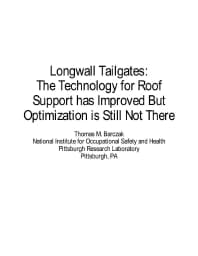Mining Publication: Longwall Tailgates: The Technology for Roof Support Has Improved, but Optimization is Still Not There
Original creation date: June 2003
Authors: TM Barczak
NIOSHTIC2 Number: 20022962
In: Proceedings of Longwall USA (Pittsburgh, PA, June 3-5, 2003), 2003 Jun; :105-130
Roof support technology for longwall tailgates has changed dramatically during the past decade. Filling tailgates with conventional wood cribs is becoming the exception rather than the rule. Modern engineered timber support systems and a host of other alternative support products provide far greater capacity, as well as stiffer response, thereby allowing the supports to resist roof movement with much less displacement than the soft wood cribbing used in the past. For these reasons, these products can provide superior roof control. In addition, the material handling requirements for support installation have now become a major consideration in the support design and selection process. Products such as conventional wood cribbing that require piecemeal construction of bulky, heavy components have diminished, while prop-type supports and products that can be installed with machinery and pumpable support technologies have grown in use, resulting in fewer injuries to mine workers. Now the opportunity exists to provide the safest, most cost-effective support system through engineering design rather than by trial and error and to optimize the use of the support system chosen. Yet this is rarely done. The key to accomplishing this task is to understand the interaction of the support system with the ground conditions at the installation site. A major focus of this paper is to conceptualize the support and interaction through the use of a ground reaction curve that relates the support resistance to the convergence of the longwall tailgate. The goal of any roof support design is to control the ground deformations and maintain the structural integrity of damaged or broken ground to the extent possible to provide a stable mine opening. In general, deformations will be a function of the stress environment and inherent strength of the surrounding rock mass. However, if the deformations are intimately linked to the stress changes such that the deformation can be controlled by the load resistance or reinforcement provided by a roof support system, then the loading behavior can be described as load-controlled. Conversely, if the deformation occurs irrespective of the installed support (assuming practical limitations), then the loading behavior is described as displacement-controlled. In this case, the deformation can be considered irresistible from a practical standpoint. In this context, the nature of the loading has significant consequences on the support design requirements. Finally, examples using the NIOSH Support Technology Optimization Program (STOP) to develop design criteria using ground reaction data from underground studies and ways to include uncontrolled convergence as part of the design criteria for standing roof supports will also be discussed.

NIOSHTIC2 Number: 20022962
In: Proceedings of Longwall USA (Pittsburgh, PA, June 3-5, 2003), 2003 Jun; :105-130
- Case History of the Response of a Longwall Entry Subjected to Concentrated Horizontal Stress
- Design Methodology for Standing Secondary Roof Support in Longwall Tailgates
- Development of Ground Response Curves for Longwall Tailgate Support Design
- Evaluation of the Impact of Standing Support on Ground Behavior in Longwall Tailgates
- A First Step in Developing Roof Support Design Criteria Based on Ground Reaction Data for Pittsburgh Seam Longwall Tailgate Support
- Pumpable Roof Supports: Developing Design Criteria by Measurement of the Ground Reaction Curve
- Rock Mass Behavior and Support Response in a Longwall Panel Pre-Driven Recovery Room
- Standing Support Alternatives in Western Longwalls
- Standing Support Alternatives in Western United States Longwalls
- Technology News 467 - Wood Crib Performance Model